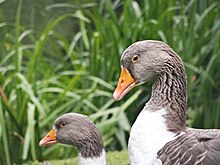Öland goose
 | |
| Conservation status | |
|---|---|
| Other names | Swedish: Ölandsgås |
| Country of origin | Sweden |
| Distribution | |
| Traits | |
| Weight |
|
| Colour | pied white and brown-grey |
| Classification | |
| EE | not recognised[3] |
| |

The Öland, Swedish: Ölandsgås, is a traditional Swedish breed of domestic goose. It is named for the island of Öland, where it is thought to have originated, and is distributed there, in Småland and in northern Skåne.[4]: 487 It is an endangered breed, with few more than a hundred living birds.
History
[edit]The Öland is a traditional breed of Öland and Götaland. It was standardised in the 1920s. The breed was nearly extinct at the 1970s.[5]
For 2021 a total population of 105 birds is reported.[2] The conservation status of the Öland was listed as "critical-maintained" by the FAO in 2007, and was listed in DAD-IS as "at risk/critical" in 2024.[1]: 112 [2]
Characteristics
[edit]The Öland is similar in appearance to the Skåne, although slightly greyer.[6] The plumage is pied white and brown-grey, with grey head and neck and patches of grey on the back, thighs and tail.[5] The bill and the legs are bright orange; there may be some white round the base of the bill.[5] Ganders generally weigh between 4.5 and 5.5 kg, geese some 4–5 kg.[5]
Use
[edit]The Ölandsgås was traditionally reared principally for meat;[7] geese lay some 20 to 30 eggs per year.[6] The birds are markedly territorial; ganders may be used to guard farm property.[6]
References
[edit]- ^ a b Barbara Rischkowsky, Dafydd Pilling (editors) (2007). List of breeds documented in the Global Databank for Animal Genetic Resources, annex to The State of the World's Animal Genetic Resources for Food and Agriculture. Rome: Commission on Genetic Resources for Food and Agriculture, Food and Agriculture Organization of the United Nations. ISBN 9789251057629. Archived 23 June 2020.
- ^ a b c Breed data sheet: Ölandsgås / Sweden (Goose (domestic)). Domestic Animal Diversity Information System of the Food and Agriculture Organization of the United Nations. Accessed November 2024.
- ^ Liste des races et variétés homologuée dans les pays EE (28.04.2013). Entente Européenne d'Aviculture et de Cuniculture. Archived 16 June 2013.
- ^ M.E. Heikkinen, M. Ruokonen, M. Alexander, J. Aspi, T. Pyhäjärvi, J.B. Searle (October 2015). Relationship between wild greylag and European domestic geese based on mitochondrial DNA. Animal Genetics. 46 (5): 485-497. doi:10.1111/age.12319.
 .
.
- ^ a b c d Gäss (in Swedish). Svenska Lanthönsklubben. Archived 20 July 2024.
- ^ a b c Öland goose. Hunnebostrand: Stiftelsen Nordens Ark. Archived 17 June 2024.
- ^ Öland goose. Västerås: Vallby Friluftsmuseum. Archived 20 August 2022.
